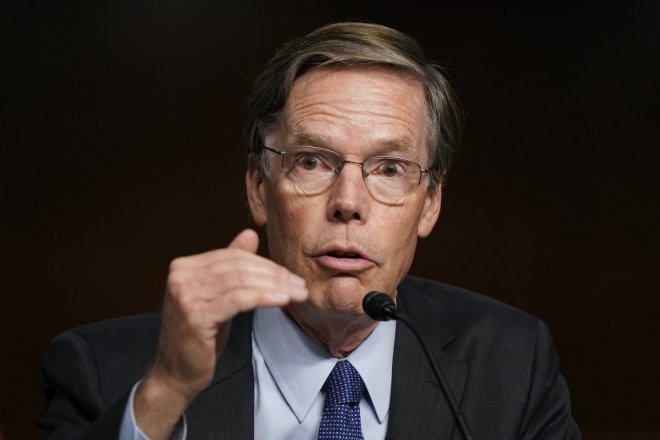
Washington is “ready to talk” to Beijing, U.S. Ambassador to China Nicholas Burns said Tuesday, calling on Beijing to “meet us halfway” to stabilize the relationship after years of tension.
“Our view is we need better channels between the two governments and deeper channels, and we are ready to talk, and it’s particularly important to do that, of course, when you’ve got big problems,” Burns said at an online event at the Stimson Center.
“We’ve never been shy of talking, and we hope the Chinese will meet us halfway on this.”
Diplomatic communication has significantly dwindled amid the deterioration of relations between Washington and Beijing under two consecutive U.S. administrations over disputes about trade, technology, human rights, and Taiwan. A visit to the self-governing island that China claims as its own by former House Speaker Nancy Pelosi to Taiwan in August further strained ties.
Burns said that “access for all of us in the U.S. government” to Chinese counterparts, including members of President Joe Biden’s cabinet “has really ebbed and flowed over the last year.”
Beijing shut down eight different channels of contact with the U.S. immediately after Pelosi departed from Taipei, “including three of our most important military channels… and the Chinese wouldn’t talk to us,” Burns told the online meeting.
However, after the Chinese Communist Party’s National Congress in October, Burns said he had “good” meetings with top Chinese foreign affairs officials Qin Gang and Wang Yi.
In November, Biden met with his counterpart, Xi Jinping, in Bali, Indonesia, ahead of the G20 summit, which Burns called “a very good, productive exchange.”
U.S. Secretary of State Antony Blinken was set for a long-anticipated Beijing visit on Feb. 5 to further repair the relationship. However, he postponed it two days before the trip after a giant Chinese “surveillance” balloon flew over the U.S. before it was shot down by a fighter jet.
Burns did not say when Blinken’s trip to China would be rescheduled, except that it would occur “when conditions are appropriate for his visit.”
“What we really need is a more broad-based engagement at the cabinet level… and it’s hard for me to predict at this point when this kind of reengagement will reoccur, but we have never supported an icing of this relationship,” Burns told the meeting virtually from Beijing.
The U.S. and China are also at odds over Beijing"s support for Russia in Ukraine as well as Chinese military incursions near Taiwan and in the South China Sea.
Climate talks continue
Burns said environment-related talks between John Kerry, Biden’s special envoy for climate issue, and Xie Zhenhua, the Chinese climate negotiator, have been ongoing, and “they work together… very effectively.”
“It doesn’t mean they always see eye to eye. But I think both governments want to work to see if we can achieve the UN target of limiting the average global increase to 1.5 degrees Centigrade,” Burns added.
China is the largest carbon emitter in the world, responsible for about 30% of global emissions, while the U.S. is second with about 10%. Burns said the two governments have a vested interest in working on the climate issue together.
Burns agreed the U.S.-China relationship has always been “complicated.”
“It’s very competitive, and it’s one that matters a lot to the United States for obvious reasons,” Burns said. He said his tenure that began 14 months earlier has “seen a continuation of all that – a difficult relationship where we’re trying to stabilize ties between us, deepen the channels between us.”
In recent weeks, Burns said, “there’s been a consistent communication between myself and senior officials in the foreign ministry, my colleagues in the U.S. mission, and their counterparts in the foreign ministry here.”
The U.S. would also like to see China push Russia to end its war in Ukraine, Burns said, adding that the recent phone call between Xi and Ukrainian President Volodymyr Zelensky was “a good first step.”
“It would be helpful if China pushed Russia to cease bombing Ukrainian schools, and Ukrainian hospitals, and Ukrainian apartment buildings.”
